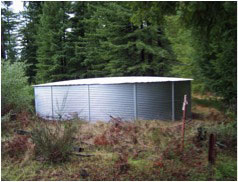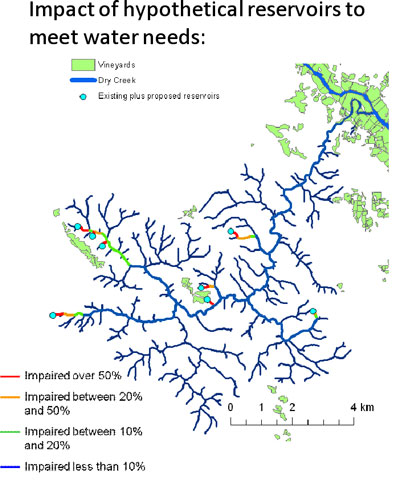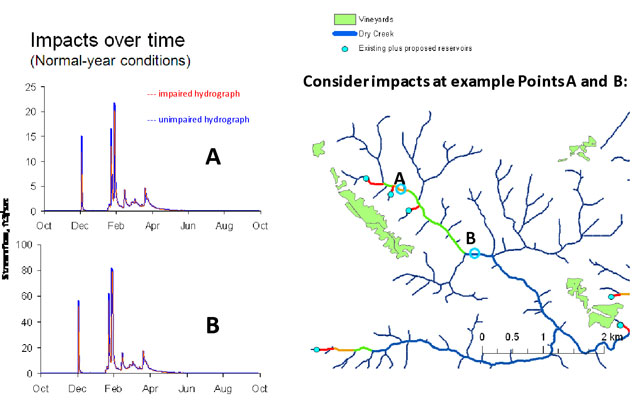Watershed-scale Models
Through
streamflow measurements
CEMAR's Conservation Hydrology program is demonstrating that there is enough water for people and the environment. Working with watershed-scale models, we are able to demonstrate how collaborative practices among landowners in a watershed can be used to manage water resources so that both people and streams get what they need.
 Traditionally, water diverters have been regulated individually, if at all, with little regard to how their actions relate to other nearby diversions or contribute to cumulative impacts on streams. Given the opportunity, water users can individually or collaboratively seek solutions to streamflow problems that can improve habitat at the most critical locations in the watershed and increase their water supply stability as well.
For example, interested parties could develop small-scale storage, such as water tanks (shown at right) or ponds (below), to capture winter flows for use in the summer. Water diverters in a watershed could even jointly manage diversion schedules so that needed streamflows are maintained at particular points in a stream.
Traditionally, water diverters have been regulated individually, if at all, with little regard to how their actions relate to other nearby diversions or contribute to cumulative impacts on streams. Given the opportunity, water users can individually or collaboratively seek solutions to streamflow problems that can improve habitat at the most critical locations in the watershed and increase their water supply stability as well.
For example, interested parties could develop small-scale storage, such as water tanks (shown at right) or ponds (below), to capture winter flows for use in the summer. Water diverters in a watershed could even jointly manage diversion schedules so that needed streamflows are maintained at particular points in a stream.
 CEMAR staff, working with collaborators at the University of California, have developed an interactive Geographic Information System (GIS) model,
which can depict graphically the human water needs, flow conditions under various scenarios, and the impacts of current water infrastructure on streamflow. This tool allows us to model the local and cumulative impacts of diversions in a watershed under different flow conditions, and we can simulate the impact of alternate diversion and storage scenarios on streamflow. Since the model is geographically explicit for a given watershed, it can realistically portray these alternative scenarios so that local landowners, fisheries agencies, and other interested parties can jointly investigate the impacts at specific locations.
CEMAR staff, working with collaborators at the University of California, have developed an interactive Geographic Information System (GIS) model,
which can depict graphically the human water needs, flow conditions under various scenarios, and the impacts of current water infrastructure on streamflow. This tool allows us to model the local and cumulative impacts of diversions in a watershed under different flow conditions, and we can simulate the impact of alternate diversion and storage scenarios on streamflow. Since the model is geographically explicit for a given watershed, it can realistically portray these alternative scenarios so that local landowners, fisheries agencies, and other interested parties can jointly investigate the impacts at specific locations.
This technique provides a valuable framework for collaborative programs to propose and test impacts of innovative, watershed-specific management solutions to provide adequate streamflow for aquatic ecosystems and reliable water supplies for agricultural and residential uses.

We can model cumulative impacts of existing reservoirs in a watershed by comparing the reservoir locations and their volumes to expected discharge through the drainage network.
We can model the cumulative water need in a watershed by assigning values of water need per acre of vineyard to each vineyard block identified through aerial photographs, and then sum those volumes of water through the drainage network.

We can model the impact of hypothetical reservoirs added to meet vineyard water needs, and illustrate how those reservoirs can affect flows through the drainage network.

We can also use these tools to look at the impacts of reservoirs at particular locations over time. In the above graphs, we are modeling how reservoirs affect streamflow through a normal-type water year, based on historical streamflow records, at Points A and B (circled on the map).
| 